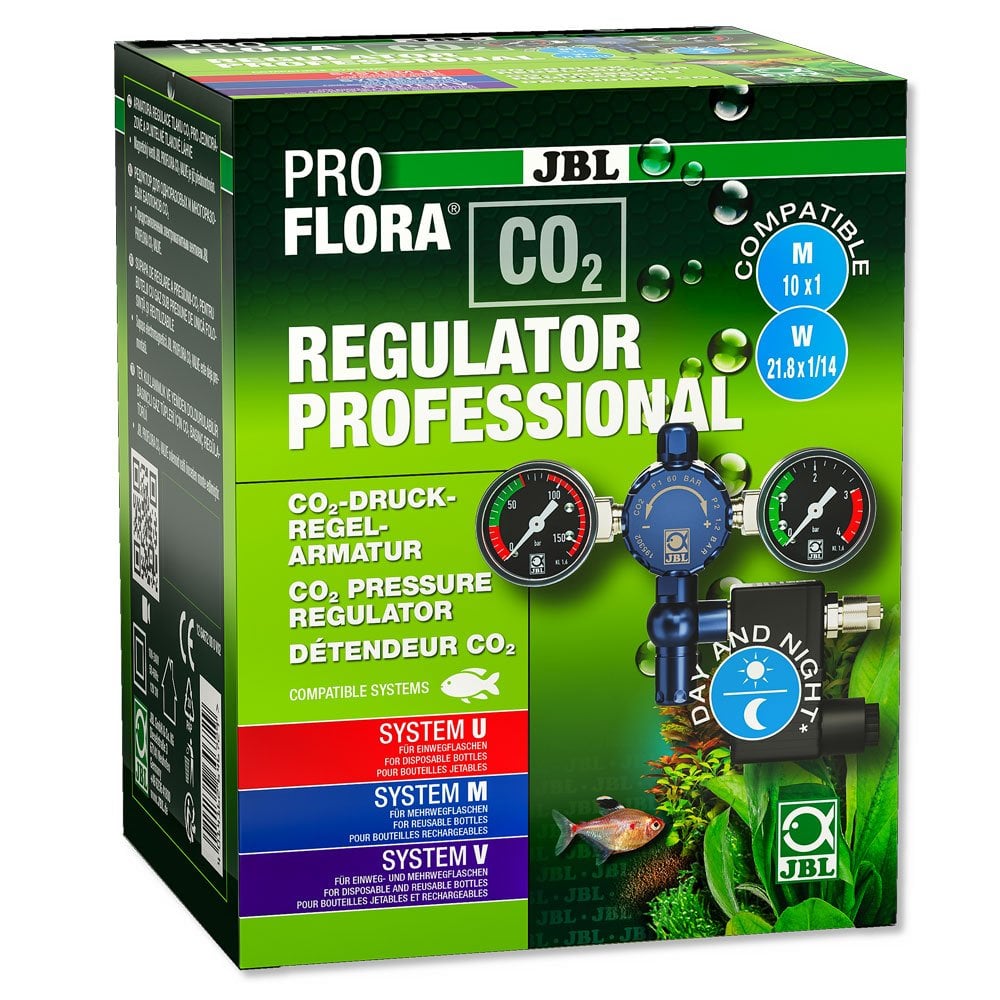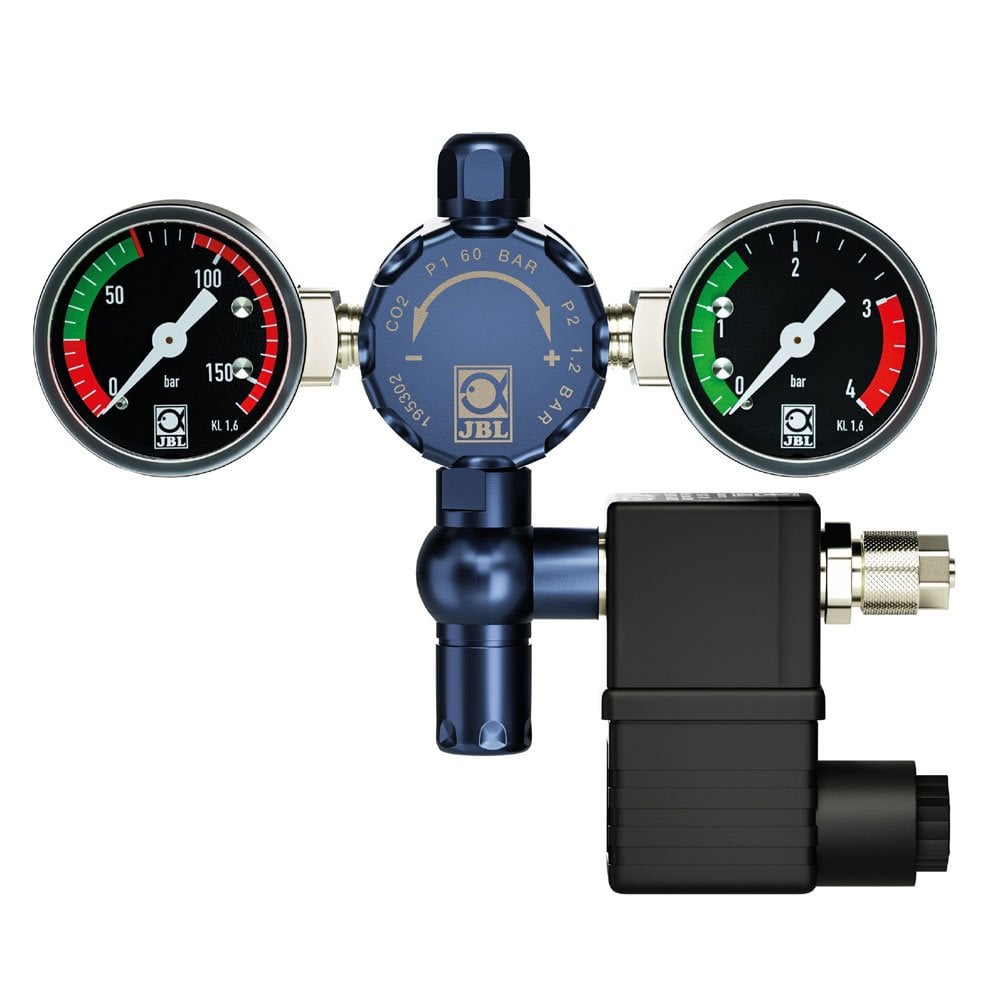-
Same Day Dispatch On orders placed before 2pm
-
Our Customers Love Us Platinum Trusted on Feefo
-
Dedicated Customer Support Call us on 01642 612 419
-
Pond Points Loyalty Scheme 2 Points for every £1 spent online
JBL ProFlora CO2 Regulator Professional
ProFlora CO2 Regulator Professional
Product Code: 6467200
- Safe and exact CO2 dosing for aquariums via easy regulation
- Easy to use Pressure Regulator
- For use with disposable JBL ProFlora U System and refillable JBL ProFlora M System CO2 cylinders
- Fine needle valve for exact adjustment of bubble count
- 2 pressure gauges display both working and cylinder pressure
- Includes JBL ProFlora CO2 Solenoid Valve for more efficient CO2 dosing
- Safe to use with incorporated pressure safety valve
- Reduces cylinder pressure from 60 to a low working 1.5 bar
- High quality design: Manufactured from anodised aluminium
- Uses reliable sealing washer instead of O-ring
- 4 year guarantee
Couldn't load pickup availability
Description
Description
The JBL ProFlora CO2 Regulator Professional offers pressure regulation of both JBL ProFlora U System and M System CO2 Cylinders. The Professional ProFlora CO2 Regulator offers easy dosing of CO2 in aquariums and comes equipped with 2 pressure gauges to display both cylinder and operating pressure and also features an excess pressure safety valve. The safety valve ensures a safe release if the working pressure is set too high, without damaging the regulator.
The Professional Regulator also includes a JBL ProFlora CO2 Solenoid Valve to aid in the delivery of CO2 as required. Without light as an energy source, plants do not absorb CO2 but still release it. Therefore planted aquariums do not require a large supply of carbon dioxide during the night. Using the ProFlora Solenoid Valve in conjunction with a timer or pH controller (timer and controller not included) the noiseless solenoid can provide CO2 as and when its required, achieving a reduction of up to 50% in CO2 usage.
Easy To Install
Screw the JBL Pressure Regulator with Solenoid Valve onto the refillable or disposable CO2 cylinder. Connect the Pressure Reducer via a hose to a bubble counter/check valve and then to the diffuser/reactor in the aquarium. Adjust the number of CO2 bubbles on the fine needle valve. Use a CO2 permanent test to provide feedback as to whether the correct amount of CO2 is added.
Safe To Use
The ProFlora CO2 Regulator is equipped with a safety relief valve, which provides a safe release of working pressure (in case it has been set too high) without damaging the fitting. The diaphragm control of the pressure reducer guarantees absolute reliability.
Function Of The Pressure Reducer
To reduce the pressure from the pressurised gas cylinder, a pressure reducer is screwed on. It reduces the 50-60 bar cylinder pressure to a working pressure of approx. 1.5 bar. This 1.5 bar is then dosed by a small handwheel (fine needle valve) so precisely that individual CO2 bubbles can be seen and counted in the connected bubble counter. The cylinder pressure and the working pressure are indicated on pressure gauges on this pressure reducer. These displays are not strictly necessary, as - unlike with diving cylinders with compressed air - the cylinder pressure does not slowly drop, and you do not need to be warned when the cylinder is running low. Instead, the pressure remains at its maximum pressure and then drops to zero in a very short time. So, unfortunately, there is no slow decrease of the cylinder filling pressure. The working pressure would only be important if it had to be adjusted. But this is normally not necessary. But a lot of people are happier having two pressure gauges giving them readings.
Delivery & Returns
Delivery & Returns
Cut Off Time
Order by 2pm for same day dispatch - Monday to Friday (Excluding Bank Holidays)
Please Note: Direct/Palletised Delivery items may take longer.
Orders Under £49
Standard Delivery (2-3 working days) - £3.99
Express Delivery (1-2 working days) - £5.99.
Orders Over £49
Standard Delivery (2-3 working days) - FREE!
Express Delivery (1-2 working days) - £2.99.
Timeframes are for standard mainland UK addresses only excluding NI, Scottish Highlands & Islands.
Palletised Deliveries
Some large oversize products, typically items weighing more than 30kg, may require delivery via pallet and as such will arrive as a kerbside delivery only. The drivers in these instances are unfortunately not permitted to assist with the pallet beyond the drop off, and cannot aid in bringing packages into the property.
Pond Planet will contact you to book in delivery on a suitable working day. Delivery will generally take place between 9am and 5pm. To ensure there are no delays with delivery, please include a contact number when placing the order.
Pond Plant Deliveries & Surcharge
Pond plants are subject to a £5.00 delivery surcharge. Pond plants are sent directly from our supplier to make sure the plants you receive are fresh and in great condition. There is no limit on how many you can order for a single delivery charge. This charge is in addition to any other carriage costs for items sent directly from Pond Planet. Please allow 5 -10 working days for delivery.
Returns
If for any reason you are not satisfied with your purchase from Pond Planet, you may return the product(s) to us within 14 days of the purchase date for a refund or exchange.
Goods must be returned in perfect and unused condition, in their original packaging. The buyer must ensures that the goods are securely and adequately packed to avoid damage and the purchaser pays all postage costs. We recommend that products are returned by recorded delivery or by a carrier that requires a signature. Pond Planet accepts no responsibility for goods returned to us unless signed proof can be provided.
-
Same Day Dispatch On orders placed before 2pm
-
Our Customers Love Us Platinum Trusted on Feefo
-
Dedicated Customer Support Call us on 01642 612 419
-
Pond Points Loyalty Scheme 2 Points for every £1 spent online


Get Expert Advice
If you have any questions or queries regarding our products or services please do not hesitate to get in touch. Our helpful team of experts are waiting on hand and want to hear from you!

Loyalty Pays!
As a thank you from us to you, we have launched our loyalty point scheme, so you can get the best out of what you spend online!


